Introduction
If you have recently paid attention to the spaceflight industry, you will have noticed quite a bit of activity. With the missions to Mars, Jupiter, asteroids, and innovations in satellite and launch vehicle technology, the space industry is front-page news again. We have not seen this level of public excitement and industry enthusiasm since the beginning of space exploration with the Sputnik launch in 1957, and the first manned spaceflight in 1961. Fast-forward fifty years to see a new round of innovation featuring small satellites in low Earth orbit (LEO) destined to bring Wi-Fi and cellular coverage to every citizen on the planet. This flurry of activity has caught the attention and heightened interest from venture capital firms and commercial company investors, never previously involved with the space industry. The first few hundred small satellite launches had limited success, and created a fragmented market. These missions spanned from grade school projects and science experiments to technology prove outs and near real-time Earth imaging.
However, it is all changing with the development of large small satellite constellations, and focused efforts from traditional satellite manufacturers concentrating on bringing broadband Internet links to every corner of the globe. Now, major semiconductor suppliers are actively figuring out how to engage this new customer base with new approaches and an entirely new business model. This article examines the emerging small satellite constellations market and explains why manufacturers are forgoing the traditional radiation-hardened components used in spaceflight for the last 50 years. We will discuss how electronic component manufacturers are addressing this potentially disruptive market, and compare new radiation-tolerant plastic ICs with the commercial off-the-shelf (COTs) ICs widely available today.
Traditional GEO Satellites vs. LEO Small Satellite Constellations
There is a growing divergence in the satellite industry. Traditional satellites typically have long mission lives (15–20yrs) and span a wide range of orbits, including geosynchronous Earth orbit (GEO) and deep spaceflight. They also have high radiation level requirements, and stringent reliability and quality requirements. On the other hand, small satellites in LEO—below the Van Allen radiation belt where most of the destructive particles are trapped—have low radiation level requirements, and their reliability and quality requirements are less stringent. Figure 1 shows hundreds of interlocked small satellites forming a LEO constellation network.
The wide chasm is fading between these two general classes of satellites. The dawning of large constellations planned for higher LEO and greater satellite capability will drive down bandwidth costs. This will require a greater amount of satellites that have slightly longer mission lives (around 5yrs), higher orbits (1,100–1,300km), higher radiation level requirements, and more stringent reliability and quality requirements.

Figure 1. Interlocked constellation of small satellites enabling global Internet access
Challenges of Using COTS Components
Because these new large constellations have slightly more demanding technical requirements than the previous small satellites, they are expected to drive up IC volumes. Despite having less electronic content per satellite versus larger traditional satellites, the sheer number of small satellites and ground support stations, drives a much larger volume quantity potential on a per product basis. These types of volume potentials are unprecedented and bring a natural expectation of lower component costs. While the technical or radiation requirements are not as rigorous as traditional satellites, the large constellation requirements can still bring considerable costs and risks. In order to drive costs down, the out of the gate tendency could be to select commercial off-the-shelf (COTS) components that are orders of magnitude lower cost versus traditional radiation hardened components. Then you formulate a test plan, execute the testing, and gather/analyze the results. In most cases, the outsourcing test costs add up quickly for both radiation testing and electrical screening, since most IC companies do not have the capability to handle this internally. In addition, the amount of man-hours to create the test plan, implement it, and analyze the data is significant because there is an associated learning curve to understanding the component being tested, or dealing with test setup issues and unexpected test results. Ultimately, there is major risk to the program cost and schedule because the IC does not yield the results needed for the program, or eventually it has significant fluctuations of yields in production screening. The bottom line: there is a lot of risk and it’s hard to predict cost adders to up-screening products that are off-the-shelf and foreign to a given company.
How does one balance the need to meet certain technical, radiation, and competitive advantage requirements by accessing commercial like performance, while keeping the costs in line to the business model for a large constellation satellites program? Since the electrical system performance of a given satellite is based on the components selected, the component manufacturer should be a part of solving the balancing of the above challenges. They are at the heart of IC innovation and are the ones most knowledgeable about a given component and the technology that it is built on. Though this sounds good in theory, despite the higher volume potentials, many component manufacturers are focused on other higher volume business and are hesitant to fully support this customer base or just don’t have the knowhow to do so. For example, some IC makers do not know if their component meets the needed radiation requirements, nor they do not have the understanding as to whether or not it could meet the requirements.
New Rad-Tolerant IC Manufacturing Flow
Those interested or the ones who have the ability and experience to support the emerging small satellite market are working to navigate this fragmented market and come up with ways to engage without dramatically changing their business model. There is not a clear cut set of industry specifications or quality standards to focus the supplier base, though there has been greater industry focus on this during the past couple of years. Seeing this emerging need and convergence of requirements for larger satellite constellations in higher LEO altitudes sparked Renesas to engage its customer base. Through in-depth engagements, Renesas has created a cost effective radiation tolerant product development and manufacturing flow to address these emerging small satellite needs. The result is a new family of products that are being released in small form factor surface mount plastic packages, typically with Nickle/Palladium/Gold (Ni/Pd/Au) lead finishes (see Figure 2).
These ICs will have a one-time characterization during development for total ionizing dose (TID) up to 30krad (Si), single event effects (SEE) with a linear energy transfer (LET) up to 43MeV, and military temperature range of -55 °C to +125 °C. The parts will also be qualified on an AEC-Q100 like qualification with testing up to 2,000 hours of burn-in, 500 temperature cycles, and package moisture sensitivity testing. This is a significantly different development and manufacturing flow versus the traditional radiation hardened products, which have large ceramic packages, radiation assurance testing in the product screening flow, and temperature and burn-in testing on each part in production—all which drives up the IC cost.
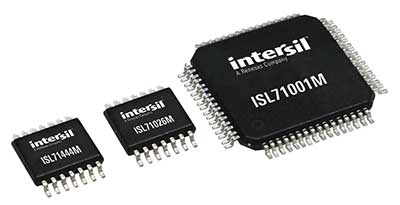
Figure 2. Surface mount plastic packages with Ni/Pd/Au-Ag lead finishes
Avoiding Catastrophic Single Event Effects
The probability of a single event effect occurring and the potential associated energy level of that event or particle would likely be lower in LEO vs. GEO, but this is still of concern for a large constellation of satellites at an altitude close to or getting in to the Van Allen Belt. For heavy digital content ICs, like a microprocessor, an SEE is typically not a catastrophic event, so cycling the power or software-based corrections typically take care of the issue. However, when it comes to the device that is powering the microprocessor or processing sensor data signals to the microprocessor, this could be a different story. Depending on the fabrication process a device is built on, a part can have a certain level of robustness against a destructive event at a given rated voltage, but where it gets more interesting is with a single event transient (SET), or a single event functional interrupt (SEFI). If a power device or an operational amplifier are impacted from a heavy ion or particle in such a way that their output is disturbed to unacceptable levels in a transient event, these devices can potentially damage or destroy the device connected to their output, like a microprocessor. In some cases, this can mean a mission failure for the whole satellite.
In a best-case scenario, an interrupt of the output can occur, which could require a power recycle, causing a disturbance to the functionality of that portion of the satellite. Within the specific IC, these type of events can only be mitigated from within the IC design. In typical commercial devices, this is usually the farthest thing from an IC designer’s mind since it is not necessary, burdens their job, and potentially affects the performance and size of the device. These all go against their objective of designing and releasing a highly competitive commercial component. The bottom line: it is easier to get away with a COTS digital type IC for LEO space applications, but don’t assume this is the case for analog or analog mixed-signal IC components. However, there are system-level techniques to help overcome this, but they will potentially add system complexity around the design, production implementation, analysis, and manufacturing or procurement, which all can add to the cost of the satellite or program. Furthermore, they can add to the size, weight, and power (SWaP) of the system solution, which goes directly against the goals of a high performance lower cost small satellite.
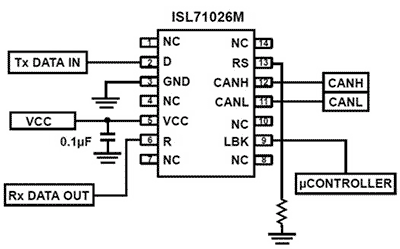
Figure 3. ISL71026M 3,3V CAN transceiver typical application circuit
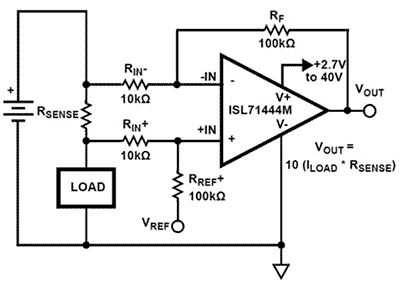
Figure 4. ISL71444M typical application: single-supply, high-side current sense amplifier
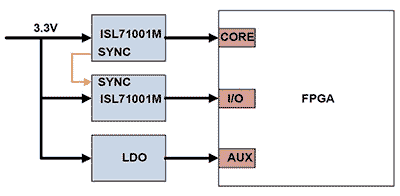
Figure 5. ISL71001M typical application providing POL power to FPGA
Ushering in a New Class of Rad-Tolerant ICs
Renesas has developed and launched three initial radiation-tolerant plastic packaged ICs. These products consist of the ISL71026M 3.3V controller area network (CAN) transceiver, the ISL71444M 40V quad precision rail-to-rail input and output (RRIO) operational amplifier, and the ISL71001M 6A point-of-load (POL) voltage regulator (see Figures 3, 4 and 5). The ISL71026M and the ISL71444M are available in a TSSOP surface mount package and the ISL71001M is available in a surface mount QFP. All of these parts have Ni/Pd/Au lead finishes to eliminate the risk of tin whisker growth.
These parts combine commercial-like performance, reliable packages, and the radiation performance needed for satellite constellation programs that are cost effective and dramatically minimize program risks. For example, Figure 6 shows that the ISL71444M quad op amp offers superior SET performance, including output settling times of less than 3µs with up to a LET of 43MeV*cm2/mg from a heavy ion strike. The user does not need to be concerned about coming up with a system level enhancement when using this op amp. In addition, since Renesas has been engaged in the satellite industry for more than 50 years, the company understands that long-term continuity of supply is critical. Everything possible is done to avoid obsoleting a product. Instead, in very rare cases, a healthy end-of-life procurement program is provided. This is a well-balanced approach to help customers meet their program metrics. In addition to large satellite constellation programs, these products are very suitable for other applications such as launch vehicles, medical equipment, high altitude avionics, and nuclear power plants.
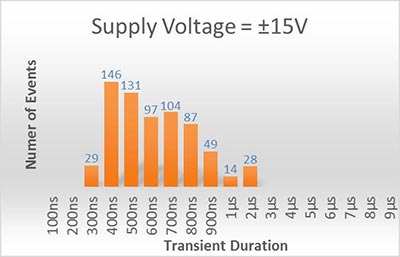
Figure 6. Single event transient performance for the ISL71444M quad op amp
Conclusion
We are currently in the midst of very exciting times for the space industry. This has included the emergence of large satellite constellations, which are poised to change the economics of a good portion of the industry. It remains to be seen how the current activity will affect the industry over the long run, but in the meantime, there is great potential in these emerging trends. These programs come with a unique set of requirements and opportunities in which the supply base is working to address. Renesas has launched a set of rad-tolerant plastic components, in addition to continuing with its traditional radiation hardened ICs, in order to provide a balanced cost effective solution that meets the needs of customers targeting LEO, GEO and deep space flights.